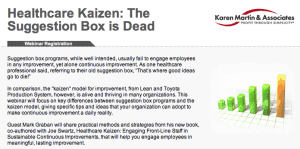Free Webinar on Tuesday, August 21, 2 pm ET
I will be giving a free webinar titled:
Healthcare Kaizen: The Suggestion Box is Dead
If you can't attend live, it will be recorded and available afterward.

Thanks to my friend Karen Martin (check out her new book The Outstanding Organization) for playing host.
I'll talk about the differences between the traditional suggestion box system (which is generally very ineffective) and a modern “kaizen” approach to continuous improvement.
What do you think? Please scroll down (or click) to post a comment. Or please share the post with your thoughts on LinkedIn – and follow me or connect with me there.
Did you like this post? Make sure you don't miss a post or podcast — Subscribe to get notified about posts via email daily or weekly.
Check out my latest book, The Mistakes That Make Us: Cultivating a Culture of Learning and Innovation:










How about “in addition to” the suggestion box instead of as a replacement for. Many organizations have been very successful at managing suggestion systems. Likely ideal for different ideas than a kaizen blitz might be able to deal with (e.g., amount of time required to evaluate & implement solution).
Great question — this is where there is confusion in terminology in the Lean world.
By “kaizen,” I mean continuous improvement that’s practiced daily, not events. I’m referring to methods like “quick and easy kaizen,” as taught by Norman Bodek, Masaaki Imai, and others.
The word kaizen has been a bit co-opted to mean, to many people, “weeklong events.” I prefer the term “Rapid Improvement Event” for that. Others call it a “blitz,” like you say. An event is fine for certain big problems that require a team, but daily kaizen is often the small stuff (that’s “quick and easy” to implement). Not everything has to be a weeklong event.
We can have (and need) both events AND daily continuous improvement.
The question is does a “suggestion box” system work as well as a modern kaizen system that’s visual, transparent, fast, and collaborative?
I’ve found organizations that are successful with suggestion systems don’t use a “box” — a box leads to an approach that’s slow, opaque, non-collaborative, and (often) anonymous.
It doesn’t have to be that way, but that’s what I’ve seen 90% of the time with suggestion box systems in healthcare — they don’t work. That’s not the box’s fault… it’s how the system is managed.
I hope you’ll tune into the webinar and let me know what you think.
Mark
Here are slides from the webinar. Recording coming soon.
http://www.slideshare.net/KarenMartin2/healthcare-kaizen